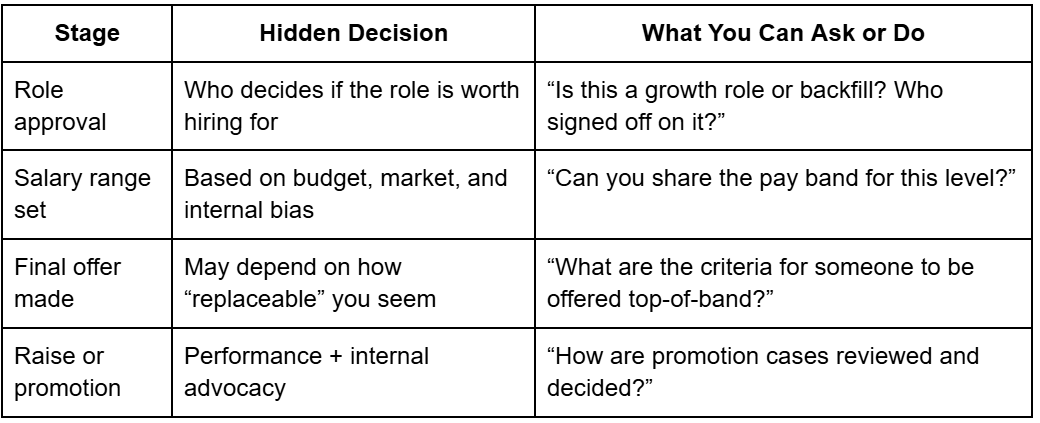Inside the Hiring Process: How Compensation and Job Offers Are Set
If you've ever wondered why some offers feel random, why promotions take forever, or why your raise barely covers groceries, it's not you. It's the system. Companies don't just wing compensation decisions. They follow a hidden playbook most job seekers never get to see.
Let’s walk through how it really works — and how you can flip the script when it’s your turn at the table.
Who Decides That a Role Needs to Be Filled?
Behind every job posting, there’s a messy group chat. Department managers identify the need. Finance checks if the money exists. HR reviews if it aligns with headcount plans. Sometimes executives step in to approve final decisions.
If you're interviewing, one of the best questions you can ask is, “Is this a new role or a backfill?” It gives you instant insight into urgency, expectations, and budget power.
Key Decision-Makers:
Department or team manager: Identifies the need.
Finance: Confirms if there's budget.
HR business partner: Reviews job justification, confirms alignment with headcount plans.
Executives or senior leaders (in smaller orgs): May approve the final role opening.
Criteria Used:
Business case (e.g. project growth, turnover, compliance requirements).
Headcount budget limits.
Strategic planning alignment.
Who Designs the Job Role and Requirements?
Spoiler: the job description was probably written by a stressed-out manager who just lost someone or needs a body on the team fast.
Hiring managers throw together what they want. HR or compensation teams review it for compliance and pay structure. Sometimes legal teams get involved too.
Don't be fooled by buzzwords. Always ask, “What does success look like in the first 90 days?” You’ll get way more real information than the job post provides.
Key Decision-Makers:
Hiring Manager: Writes the job description and defines what they want.
HR or Compensation Team: Reviews for structure, alignment with pay bands, compliance.
Sometimes Legal/Union Reps: If it's a unionized or regulated position.
Criteria Used:
Internal leveling guides.
Benchmark data from tools like Mercer, Radford, or BLS (Bureau of Labor Statistics).
Internal equity: how others in similar roles are paid.
Who Decides Salary Range and Offer Amount?
Salary bands don’t appear out of nowhere. Compensation analysts pull benchmark data, check internal equity, and set approved ranges. The hiring manager can suggest where you land, but recruiters and finance often have the final say on exceptions.
Your move? Early in the process, ask: “What is the approved salary range for this role?” If they dodge, that’s a red flag.
Key Decision-Makers:
Compensation Analyst or HR: Sets base salary band based on market data and internal equity.
Hiring Manager: May suggest where in that band to place the offer.
Recruiter: Delivers the offer, sometimes negotiates on behalf of the team.
Final approval: Often needed from a department director, VP, or finance leader for anything outside the standard.
Criteria Used:
External market benchmarks.
Internal pay equity.
Candidate’s experience (sometimes narrowly defined).
Budget restrictions.
Risk of losing the candidate to a competitor.
Who Makes the Final Hiring Decision?
The hiring manager usually has the final say. But interview panels, HR, DEI leads, and sometimes executives all have influence. It’s rarely a solo call.
If you want the real scoop, ask: “Can you walk me through how hiring decisions are made here?” It tells you who has power — and who doesn’t.
Key Decision-Makers:
Hiring Manager: Usually has final say.
Interview Panel: Provides feedback that heavily influences the decision.
HR or DEI Lead: May do a bias check or diversity review in some companies.
Executives (for higher roles): May sign off on Director+ hires.
Decision-Making Process:
Interview scores are discussed.
Candidate “fit” is assessed (often coded language for identity bias).
Final candidate is reviewed for budget fit.
Who Approves Raises, Promotions, and Bonuses?
Raises and promotions are a whole other political game.
Managers submit cases for pay bumps. Compensation teams review for budget and fairness (sometimes). People committees “calibrate” across teams, comparing employees against each other. Executives sign off, especially if the money’s big.
During an offer, ask: “How are raises and promotions structured here?” If they can’t answer clearly, know that advocacy (yours) will be essential.
Key Decision-Makers:
Manager: Submits the case for increase or promotion.
Compensation Team: Reviews for budget and pay equity.
People Committee or Calibration Group: In some companies, managers meet to “rank” performance and align decisions across teams.
Executives: Must approve off-cycle or high-dollar raises.
Criteria Used:
Performance rating.
Peer comparisons.
Budget available.
Whether the employee is considered a “flight risk” (likely to leave).
Why the Process Feels Hidden
Most managers don't even fully understand how compensation works. And companies like it that way. The less you know, the easier it is to lowball you, delay your promotion, and pretend inequities don't exist.
Hiring isn’t just about skills. It’s about budget battles, politics, bias, and risk management. Knowing that lets you navigate it like a boss.
Decoding The Hiring Process Power + Leverage Points for Job Seekers
FAQs About the Hiring Process and Salary Decisions
-
Compensation teams set the range, but hiring managers and finance often decide where you land within it.
-
Yes. And you should. Asking early shows confidence and protects you from wasting time.
Know the Game. Play It to Win.
Understanding who holds the real power at each stage changes the way you advocate for yourself. It stops you from taking offers at face value and gives you language to push for better.
If you’re tired of feeling like decisions are happening to you instead of with you, it’s time to flip the power dynamic.

